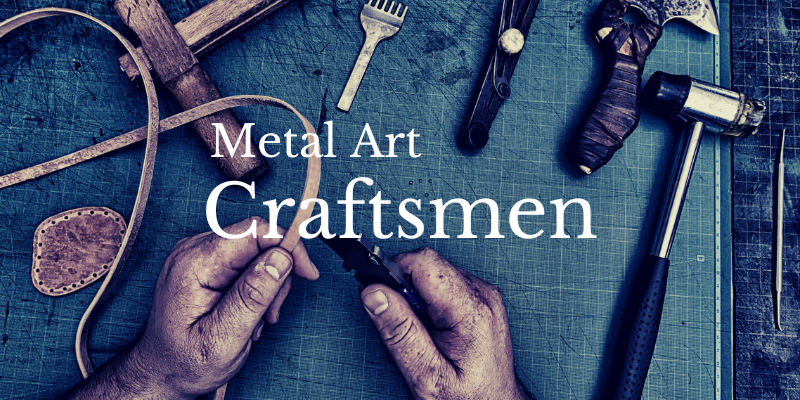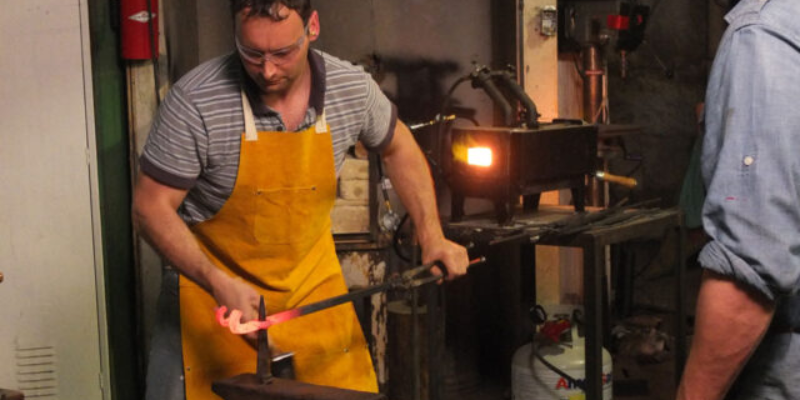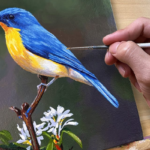Exploring Metal Art Crafting Beauty Through Steel and Fire

Metal art is an ancient craft, transcending time to become a modern medium of artistic expression. From intricate sculptures to functional design, metal has been shaped and molded to create pieces that are both beautiful and enduring.
In this piece, we will explore the evolution, techniques, and stunning outcomes of metal art, demonstrating its versatility and the intricate craftsmanship behind it.
The Evolution of Metal Art
Metal art has been part of human history for millennia, originating in early civilizations such as Mesopotamia and Egypt. Ancient metalworkers crafted jewelry, armor, and statues, laying the foundation for modern techniques.
Over time, metal art evolved into diverse forms, from ornamental to practical, reflecting the cultural and technological advancements of each era.
Types of Metal Used in Art
One of the most striking aspects of metal art is the variety of metals used. Common materials include:
Steel Known for its strength and industrial aesthetic, steel is often used in large sculptures and installations.
Copper Copper’s malleability and ability to develop a natural patina make it a favorite among artists seeking to create intricate or textured pieces.
Bronze An alloy of copper and tin, bronze is favored for casting statues and sculptures due to its durability and timeless appearance.
Aluminum Lightweight and resistant to corrosion, aluminum is ideal for outdoor metal art and minimalist designs.
Each type of metal lends unique properties to the art, allowing artists to explore a wide range of styles and applications.
Techniques in Metal Art

The creation of metal art involves a range of specialized techniques, many of which have been developed and refined over centuries. These include:
Forging A process where metal is heated and hammered into shape, commonly used for creating sculptures and functional art pieces like gates or furniture.
Casting Involves pouring molten metal into a mold to create detailed and complex shapes. It’s commonly used in bronze sculpture.
Welding Fuses metal pieces together, often used in modern metal art to create large-scale installations or abstract forms.
Cutting Methods such as plasma cutting or laser cutting allow for precise designs and intricate patterns in metal.
Etching Involves engraving designs into the surface of metal, adding fine details to the artwork.
These techniques require skill and patience, as the artist works to mold the raw material into something extraordinary.
Metal Art in Contemporary Culture
Today, metal art can be found in galleries, homes, and public spaces around the world. It is embraced by both traditional and avant-garde artists, who use it to make bold statements or create visually stunning pieces that evoke emotion.
Metal art can be functional, such as in furniture design, or purely aesthetic, as seen in sculptures and wall art. The versatility of metal allows for limitless creativity in design.
Famous Metal Artists and Their Masterpieces
Several renowned artists have left their mark on the world of metal art:
Alexander Calder Known for his kinetic sculptures, Calder revolutionized metal art by creating mobiles that combined engineering with art.
Richard Serra Famous for his massive steel sculptures, Serra’s work challenges perceptions of space and scale.
David Smith A pioneer in abstract expressionist metal sculpture, Smith’s works are both monumental and intricate.
These artists have paved the way for contemporary metalworkers, inspiring new generations to explore the medium.
The Beauty of Functional Metal Art
Metal art isn’t just about aesthetics—it often serves a functional purpose. Many artists create functional pieces like metal furniture, gates, and fixtures, where beauty and practicality intersect.
Metal lends itself to sleek, modern designs or can be crafted into intricate, ornate styles. Whether it’s a wrought iron gate or a sculptural chandelier, functional metal art adds a touch of craftsmanship to everyday objects.
The Rise of Recycled Metal Art
With the growing focus on sustainability, many artists are turning to recycled metals for their creations. Using scrap metal, discarded industrial parts, or even car parts, artists can transform waste into works of art.
This not only promotes environmental consciousness but also adds character and uniqueness to the pieces. The rough, weathered look of recycled metal often adds an extra layer of depth to the art, making it even more captivating.
Metal Art in Architecture
Metal has also found its place in architectural design, blending art and functionality. From ornate metal railings and gates to large-scale sculptures integrated into buildings, metal art enhances both interiors and exteriors.
Architects often collaborate with metal artists to create facades, installations, and decorative elements that reflect the character of the space. The use of metal in architecture exemplifies the versatility and strength of the material.
How to Care for Metal Art
To preserve the beauty and integrity of metal art, proper care and maintenance are essential. While some metals like stainless steel and aluminum are resistant to corrosion, others, like iron or copper, require protection against rust and oxidation. Common practices include:
Cleaning Gently cleaning the metal with a soft cloth and mild detergent to remove dust and grime.
Polishing Metals like bronze and steel may need periodic polishing to restore their shine.
Sealing Applying a protective sealant can prevent rust and tarnish, especially for outdoor pieces.
Repairing For damage or wear, it may be necessary to consult a professional to repair the artwork, particularly with delicate or intricate designs.
Caring for metal art not only maintains its appearance but also prolongs its lifespan.
The Future of Metal Art
As technology advances, so too does the potential for innovation in metal art. Techniques such as 3D printing and computer-aided design (CAD) are opening up new possibilities for precision and complexity in metal art.
Artists are now able to experiment with intricate patterns, shapes, and textures that were previously unimaginable.
Additionally, the fusion of metal with other materials, such as glass or wood, is creating hybrid art forms that push the boundaries of creativity.
Conclusion
Metal art is a dynamic and evolving form of artistic expression, bridging the gap between tradition and modernity. Through the use of various metals and techniques, artists have the ability to craft extraordinary pieces that range from functional to purely decorative.
As technology continues to evolve and sustainability becomes more important, metal art is poised to remain a powerful medium for creativity and innovation. Whether forged from steel, cast in bronze, or welded from recycled materials, metal art continues to captivate and inspire.
Timeless Craftsmanship Metal art is an ancient art form that blends tradition with modern design, making it both timeless and innovative.
Durability Metal art is highly durable, capable of withstanding harsh environmental conditions, especially in outdoor settings.
Versatile Medium Artists use various metals like steel, bronze, and copper, allowing for endless creativity and artistic expression.
Customizable Metal art can be tailored to personal preferences, making it perfect for unique, one-of-a-kind pieces for homes, offices, or public spaces.
Eco-Friendly Options Recycled metal art is a sustainable option, transforming waste materials into stunning works of art.
Functional Beauty Many metal art pieces serve practical purposes, such as furniture, gates, and lighting, merging aesthetics with functionality.
Modern Techniques Advances in technology, such as 3D printing and laser cutting, are expanding the possibilities of metal art design.
Variety of Styles Metal art ranges from abstract sculptures to intricate wall pieces, fitting into a wide range of artistic and architectural styles.
Low Maintenance With proper care, metal art remains beautiful for years, often requiring minimal upkeep beyond occasional cleaning and polishing.
Statement Pieces Metal art is bold and eye-catching, often used to make a strong visual impact in any setting.
Frequently Asked Questions:
What is metal art?
Metal art refers to artistic creations made from various types of metals, such as steel, bronze, aluminum, and copper.
It encompasses a wide range of forms, including sculptures, wall art, jewelry, and functional pieces like furniture.
What metals are commonly used in metal art?
The most commonly used metals in metal art are steel, copper, bronze, aluminum, and iron. Each type of metal has unique properties that influence the design and crafting process, making them suitable for different kinds of art.
What techniques are used in metal art?
Metal art involves several techniques such as forging, welding, casting, etching, and cutting. These methods allow artists to manipulate metal into various shapes, designs, and textures, ranging from fine detail to large-scale works.
Is metal art durable?
Yes, metal art is known for its durability. Metals like steel, aluminum, and bronze are highly resistant to weathering and corrosion, making them ideal for both indoor and outdoor artwork.
However, some metals require maintenance to prevent rust or oxidation.
How do I care for metal art?
Caring for metal art involves regular cleaning, polishing, and sometimes applying a protective sealant. For outdoor metal art, it’s important to protect the piece from moisture and harsh weather conditions to prevent rust or tarnish.
Can metal art be customized?
Absolutely! Many artists offer custom metal art services, allowing clients to choose specific designs, sizes, and materials. Whether it’s a personalized sculpture, wall art, or a functional piece, metal art can be tailored to meet individual preferences.
What is recycled metal art?
Recycled metal art is created using scrap metal or discarded materials, often repurposed from industrial parts, cars, or old tools.
This approach not only creates unique, one-of-a-kind pieces but also promotes environmental sustainability by reducing waste.
What is the difference between forged and cast metal art?
Forged metal art involves heating metal and then hammering it into shape, often by hand. Cast metal art, on the other hand, involves pouring molten metal into a mold to create a specific form.
Both methods result in stunning, durable art but offer different textures and aesthetics.
Where can I display metal art?
Metal art can be displayed both indoors and outdoors. For outdoor installations, materials like stainless steel, aluminum, or weather-treated bronze are ideal due to their durability and resistance to the elements.
How has technology impacted metal art?
Technology, such as 3D printing and computer-aided design (CAD), has revolutionized metal art by enabling greater precision, complexity, and creativity.
Artists can now create intricate designs and large-scale works with more detail than ever before.









